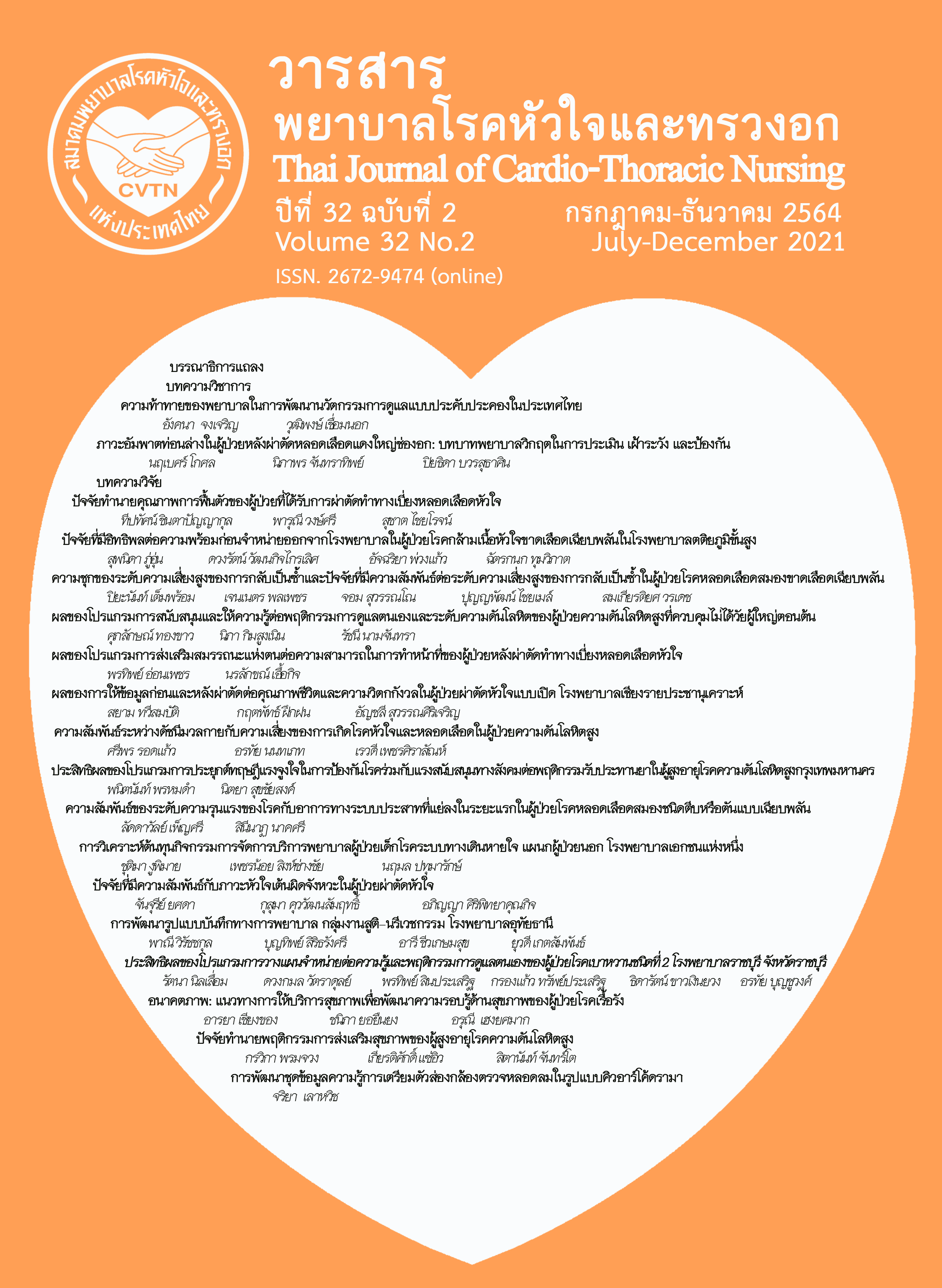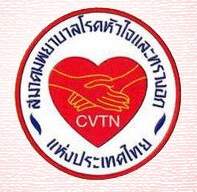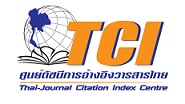Paraplegia after thoracic aortic aneurysm surgery: critical care nurses’ role in assessment, detection, and prevention
Keywords:
thoracic aortic aneurysm surgery, paraplegia, roles of critical nurse, assessment, detection, preventionAbstract
Paraplegia from spinal cord injury is one of the most emergent and devastating neurological complications in patients after thoracic aortic aneurysm surgery. The pathology of paraplegia may occur in pre, intra, and post-surgery caused by risk factors including patient risk, surgical factor, clinical factor requiring immediate treatment. Without timely management, it may lead to death, disability, lower levels of life satisfaction, and burden on their family members. Nurses are health care providers who play an important role in assessing and monitoring patients closely to detect signs and symptoms of paraplegia and early detect them to reduce further complications. The aim of this article is to reveal that critical care nurses should focus on assessing and monitoring continuously for early detection of neurological complications, from admission to discharge or transfer out of an intensive care unit. Nurses need to have knowledge and competent skills to assess and detect paraplegia related to thoracic aortic aneurysm surgery effectively and apply knowledge for prevention and care in the context of their settings appropriately.
References
Wei L, Bu X, Wang X, Liu J, Ma A, MD, Wang T. Global Burden of Aortic Aneurysm and Attributable Risk Factors from 1990 to 2017. Glob Heart. 2021;16(1):35.
Sampson UKA, Norman PE, Fowkes FGR, Aboyans V, Song Y, Harrell YE, et al. Global and regional burden of aortic dissection and aneurysms: mortality trends in 21 world regions, 1990 to 2010. Glob Heart. 2014;9(1):171-180.
Kanoksin S. Management of complication of aortic dissection. The Society of Thoracic Surgeons of Thailand. [cited 2020 September 29 ]. Available from http://thaists.org/news_ files/ news_file_495.pdf (in Thai).
Acher C, Wynn M. Paraplegia after thoracoabdominal aortic surgery: not just assisted circulation, hypothermic arrest, clamp and sew, or TEVAR. Ann. Cardiothorac. Surg. 2012;1(3):365-72.
Scali ST, Wang SK, Feezor RJ, Huber TS, Martin TD, Klodell CT, et al. Preoperative prediction of spinal cord ischemia after thoracic endovascular aortic repair. J. Vasc. Surg. 2014; 60(6):1481-90.
Bisdas T, Panuccio G, Sugimoto M, Torsello G, Austermann M. Risk factors for spinal cord ischemia after endovascular repair of thoracoabdominal aortic aneurysms. J. Vasc. Surg. 2015; 61(1):1408-16.
Mehmedagic I, Jörgensen S, Acosta S. Mid-term follow-up of patients with permanent sequel due to spinal cord ischemia after advanced endovascular therapy for extensive aortic disease. Spinal Cord. 2015; 53:232–37.
Kirshblum SC, Burns SP, Sorensen FB, Donovan W, Graves DE, Jha A, et al. International standards for neurological classification of spinal cord injury (Revised 2011). J Spinal Cord Med. 2011; 34(6): 535-46.
Wongkornrat W, Yamamoto S, Sekine Y, Ono M, Fujikawa T, Oshima S, et al. Predictors of paraplegia with current thoracoabdominal aoric aneurysm repair. Asian Cardiovasc Thorac Ann. 2015; 23(4):406-11.
Buth J, Harris PL, Hobo R, EpsRv, Cuypers P, Duijm L, et al. Neurologic complications associated with endovascular repair of thoracic aortic pathology: Incidence and risk factors. a study from the European Collaborators on Stent/Graft Techniques for Aortic Aneurysm Repair (EUROSTAR) registry. J Vasc Surg. 2007; 46(6):1103-10.
Chiesa R, Melissano G, Marrocco-Trischitta MM, Civilini E, Setacci F. Spinal cord ischemia after elective stent-graft repair of the thoracic aorta. J Vasc Surg. 2015; 42(1):11-7.
Coselli JS, LeMaire SA, Miller III CC, Schmittling ZC, Ko¨ksoy C, Pagan J, et al. Mortality and paraplegia after thoraco abdominal aortic aneurysm repair: a risk factor analysis. Ann. Thorac. Surg. 2002; 69(2):409–14.
Greenberg RK, Lu Q, Roselli EE, Svensson LG, Moon MC, Hernandez AV, et al. Contemporary analysis of descending thoracic and thoracoabdominal aneurysm repair: a comparison of endovascular and open techniques. Circulation. 2008;118(8):808-17.
Pitaksuteepong T. The five years registry of acute aortic dissection in Prapokklao Hospital. Journal Prapokklao Hospital Clinical Med Education Center. 2008; 25(2):96-107. (in Thai).
Ullery BW, Cheung AT, Fairman RM, Jackson BM, Woo EY, Bavaria J, et al. Risk factors, outcomes, and clinical manifestations of spinal cord ischemia following thoracic endovascular aortic repair. J Vasc Surg. 2011; 54(3):677-84.
Feezor RJ, Martin TD, MD, Hess PJ, Daniels MJ, Beaver TM, Klodell CT, Lee WA. Extent of aortic coverage and incidence of spinal cord ischemia after thoracic endovascular aneurysm repair. Ann Thorac Surg. 2008;86:1809 –14.
Cina CS, Abouzahr L, Arena GO, Lagana A, Devereaux PJ, Farrokhyar F. Cerebrospinal fluid drainage to prevent paraplegia during thoracic and thoracoabdominal aortic aneurysm surgery: a systematic review and meta-analysis. J. Vasc. Surg. 2004; 40(1):36-44.
Hiratzka LF, Bakris GL, Beckman JA, Bersin RM, Carr VF, Casey DE Jr, et al. 2010 ACCF/AHA/AATS/ACR/ASA/SCA/SCAI/SIR/STS/SVM guidelines for the diagnosis and management of patients with thoracic aortic disease: a report of the American College of Cardiology Foundation/ American Heart Association Task force on practice guidelines, American Association for Thoracic Surgery, American College of Radiology, American Stroke Association, Society of Cardiovascular Anesthesiologists, Society for Cardiovascular Angiography and Interventions, Society of Interventional Radiology, Society of Thoracic Surgeons, and Society for Vascular Medicine. Circulation. 2010;121:e266369.
Etz CD, Weigang E, Hartert M, Lonn L, Mestres CA, Bartolomeo RD, et al. Contemporary spinal cord protection during thoracic and thoracoabdominal aortic surgery and endovascular aortic repair: a position paper of the vascular domain of the European Association for Cardio-Thoracic Surgery. Eur J Cardiothorac Surg. 2015; 47(6):943-57.
Conrad MF, Ye JY, Chung TK, Davison JK, Cambria RP. Spinal cord complications after thoracic aortic surgery: long-term survival and functional status varies with deficit severity. J Vasc Surg. 2008;48(1):47-53.
Wong DR, Coselli JS, Amerman K, Bozinovski J, Carter SA, Vaughn WK, et al. Delayed spinal cord deficits after thoracoabdominal aortic aneurysm repair. Ann Thorac Surg. 2000; 83(4):1345-55.
Augoustidesa JG, Stoneb ME, Drengerc B. Novel approaches to spinal cord protection during thoracoabdominal aortic interventions. J. Cardiothorac. Vasc. Anesth. 2014;27(1):98-105.
Cheung AT, Pochettino A., Mcgarvey ML, Appoo JJ, Fairman RM, Carpenter JP, et al. Strategies to manage paraplegia risk after endovascular stent repair of descending thoracic aortic aneurysm. Ann. Thorac. Surg. 2015; 80(4):1280-8.
Khan SN &Stansby G. Cerebrospinal fluid drainage for thoracic and thoracoabdominal aortic aneurysm surgery. Cochrane Database Syst Rev. 2012;10(10):CD003635.
Youngblood SC, Tolpin DA, LeMaire SA, Coselli JS, Lee VV, Cooper JR. Complications of cerebrospinal fluid drainage after thoracic aortic surgery: a review of 504 patients over 5 years. J Thorac Cardiovasc Surg. 2013; 146(1):166-71.
Coselli JS, LeMaire SA, Köksoy C, Schmittling ZC, Curling PE. Cerebrospinal fluid drainage reduces paraplegia after thoracoabdominal aortic aneurysm repair: results of a randomized clinical trial. J Vasc Surg. 2002;35(4):631-9.
Dardik A, Perler BA, Roseborough JS, Williams GM. Subdural hematoma after thoracoabdominal aortic aneurysm repair: an underreported complication of spinal fluid drainage? J Vasc Surg. 2002;36(1):47-50.
Awad H, Ramadan ME, Sayed HF, Tolpin DA, Tili E, Collard CD. Spinal cord injury after thoracic endovascular aortic aneurysm repair. Can J Anaesth. 2017;64(12):1218-35.
Downloads
Published
How to Cite
Issue
Section
License
Copyright (c) 2022 Thai Journal of Cardio-Thoracic Nursing

This work is licensed under a Creative Commons Attribution-NonCommercial-NoDerivatives 4.0 International License.
บทความนี้ยังไม่เคยตีพิมพ์หรืออยู่ในระหว่างส่งไปตีพิมพ์ในวารสารอื่น ๆ มาก่อน และกองบรรณาธิการขอสงวนสิทธิ์ในการตรวจทาน และแก้ไขต้นฉบับตามเกณฑ์ของวารสาร ในกรณีที่เรื่องของท่านได้ได้รับการตีพิมพ์ในวารสารฉบับนี้ถือว่าเป็น ลิขสิทธิ์ของวารสารพยาบาลโรคหัวใจและทรวงอก





